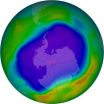(Press-News.org) VIDEO:
This NASA video discusses new research that shows Earth's atmosphere contains an unexpectedly large amount of an ozone-depleting compound from an unknown source decades after the compound was banned worldwide....
Click here for more information.
NASA research shows Earth's atmosphere contains an unexpectedly large amount of an ozone-depleting compound from an unknown source decades after the compound was banned worldwide.
Carbon tetrachloride (CCl4), which was once used in applications such as dry cleaning and as a fire-extinguishing agent, was regulated in 1987 under the Montreal Protocol along with other chlorofluorocarbons that destroy ozone and contribute to the ozone hole over Antarctica. Parties to the Montreal Protocol reported zero new CCl4 emissions between 2007-2012.
However, the new research shows worldwide emissions of CCl4 average 39 kilotons per year, approximately 30 percent of peak emissions prior to the international treaty going into effect.
"We are not supposed to be seeing this at all," said Qing Liang, an atmospheric scientist at NASA's Goddard Space Flight Center in Greenbelt, Maryland, and lead author of the study. "It is now apparent there are either unidentified industrial leakages, large emissions from contaminated sites, or unknown CCl4 sources."
As of 2008, CCl4 accounted for about 11 percent of chlorine available for ozone depletion, which is not enough to alter the decreasing trend of ozone-depleting substances. Still, scientists and regulators want to know the source of the unexplained emissions.
For almost a decade, scientists have debated why the observed levels of CCl4 in the atmosphere have declined slower than expectations, which are based on what is known about how the compound is destroyed by solar radiation and other natural processes.
"Is there a physical CCl4 loss process we don't understand, or are there emission sources that go unreported or are not identified?" Liang said.
With zero CCl4 emissions reported between 2007-2012, atmospheric concentrations of the compound should have declined at an expected rate of 4 percent per year. Observations from the ground showed atmospheric concentrations were only declining by 1 percent per year.
To investigate the discrepancy, Liang and colleagues used NASA's 3-D GEOS Chemistry Climate Model and data from global networks of ground-based observations. The CCl4 measurements used in the study were made by scientists at the National Oceanic and Atmospheric Administration's (NOAA's) Earth System Research Laboratory and NOAA's Cooperative Institute for Research in Environmental Sciences at the University of Colorado, Boulder.
Model simulations of global atmospheric chemistry and the losses of CCl4 due to interactions with soil and the oceans pointed to an unidentified ongoing current source of CCl4. The results produced the first quantitative estimate of average global CCl4 emissions from 2000-2012.
In addition to unexplained sources of CCl4, the model results showed the chemical stays in the atmosphere 40 percent longer than previously thought. The research was published online in the Aug. 18 issue of Geophysical Research Letters.
"People believe the emissions of ozone-depleting substances have stopped because of the Montreal Protocol," said Paul Newman, chief scientist for atmospheres at NASA's Goddard Space Flight Center, and a co-author of the study. "Unfortunately, there is still a major source of CCl4 out in the world."
INFORMATION:
NASA monitors Earth's vital signs from land, air and space with a fleet of satellites and ambitious airborne and ground-based observation campaigns. NASA develops new ways to observe and study Earth's interconnected natural systems with long-term data records and computer analysis tools to better see how our planet is changing. The agency shares this unique knowledge with the global community and works with institutions in the United States and around the world that contribute to understanding and protecting our home planet.
For more information about NASA's Earth science activities in 2014, visit:
http://www.nasa.gov/earthrightnow
For information on the Antarctic ozone hole, visit:
http://ozonewatch.gsfc.nasa.gov
Ozone-depleting compound persists, NASA research shows
2014-08-20
ELSE PRESS RELEASES FROM THIS DATE:
Blueprint for next generation of chronic myeloid leukemia treatment
2014-08-20
SALT LAKE CITY— Researchers at Huntsman Cancer Institute (HCI) at the University of Utah have identified and characterized mutated forms of the gene that encodes BCR-ABL, the unregulated enzyme driving the blood cancer chronic myeloid leukemia (CML). According to the American Cancer Society, nearly 6,000 new cases of CML will be diagnosed in 2014.
Drugs already in use, called tyrosine kinase inhibitors (TKIs), target BCR-ABL and are effective at controlling the disease. They do not cure CML but control it in a way that allows patients to get back to normal life and a ...
Water leads to chemical that gunks up biofuels production
2014-08-20
RICHLAND, Wash. -- Trying to understand the chemistry that turns plant material into the same energy-rich gasoline and diesel we put in our vehicles, researchers have discovered that water in the conversion process helps form an impurity which, in turn, slows down key chemical reactions. The study, which was reported online at the Journal of the American Chemical Society, can help improve processes that produce biofuels from plants.
The study examines the conversion of bio-oil, produced from biomass such as wood chips or grasses, into transportation fuels. Researchers ...
Salmon forced to 'sprint' less likely to survive migration
2014-08-20
Sockeye salmon that sprint to spawning grounds through fast-moving waters may be at risk, suggests new research by University of British Columbia scientists.
When salmon encounter turbulent, fast-moving water – such as rapids or areas downstream of dams – they must move upstream using a behaviour known as "burst swimming" that is similar to sprinting for humans.
"Days after sockeye passed through extremely fast-moving water, we started to see fish dying only a short distance from their spawning grounds," said Nicholas Burnett, a research biologist at UBC and lead author ...
Pain treatments less effective for those with irritable bowel
2014-08-20
University of Adelaide researchers have discovered that the immune system is defective in people suffering from irritable bowel syndrome, which is a major reason why sufferers have ongoing issues with pain.
The research – the first of its kind in the world – could also help to explain why some painkillers may not offer satisfactory relief to sufferers.
Irritable bowel syndrome (IBS) affects up to 10% of the community. There are different forms of IBS but all of them involve unexplained gut pain, which often has the greatest impact on sufferers' quality of life.
Scientists ...
Pica in pregnant teens linked to low iron
2014-08-20
ITHACA, N.Y. – In a study of 158 pregnant teenagers in Rochester, NY, nearly half engaged in pica – the craving and intentional consumption of ice, cornstarch, vacuum dust, baby powder and soap, and other nonfood items, reports a new Cornell study.
Moreover, such teens had significantly lower iron levels as compared with teens who did not eat nonfood substances.
Pregnant teens, regardless of pica, are at higher risk for low hemoglobin, which can lead to iron deficiency and anemia. Low iron in pregnant teens raises the risk of premature births and babies with low birth ...
Research: tax benefits for housing not as outsized as previously thought
2014-08-20
New research co-written by a University of Illinois expert in urban economics indicates that tax benefits for housing, including the ever-popular mortgage interest deduction and the property tax deduction, are not as distortionary as previous research and some prominent critics suggest.
The existing system of tax benefits for housing caused the typical house to be 4 percent too large in 2007, creating a national economic waste of $7 billion per year – a figure that is substantially smaller than recent estimates by other economists, including some who have pegged the figure ...
Missing protein restored in patients with muscular dystrophy
2014-08-20
Advances in the treatment of muscular dystrophy: For the first time, a research team has succeeded in restoring a missing repair protein in skeletal muscle of patients with muscular dystrophy. Researchers from the University and the University Hospital of Basel, Department of Biomedicine and Clinic of Neurology, report their recent findings in the scientific journal Science Translational Medicine.
When muscle cell membranes are damaged, the repair protein dysferlin is activated and reseals muscle membrane tears. If this repair protein is altered due to a genetic mutation, ...
Researchers pinpoint most common causes of dangerous eye infection post surgery and trauma
2014-08-20
NEW YORK -- The most common cause of endophthalmitis, a potentially blinding condition that can occur after eye trauma, eye surgery, and eye injections, are the well-known staphylococci ("staph") and streptococci ("strep") bacterial strains, according to a study published in the August issue of Ophthalmology and based on a review of 25 years of cases at New York Eye and Ear Infirmary of Mount Sinai (NYEE).
The new study found that gram-positive bacteria, which include staph and strep infections, accounted for 95 percent of endophthalmitis cases. The findings could lead ...
Maturing brain flips function of amygdala in regulating stress hormones
2014-08-20
In contrast to evidence that the amygdala stimulates stress responses in adults, researchers at Yerkes National Primate Research Center, Emory University have found that the amygdala has an inhibitory effect on stress hormones during the early development of nonhuman primates.
The results are published this week in Journal of Neuroscience.
The amygdala is a region of the brain known to be important for responses to threatening situations and learning about threats. Alterations in the amygdala have been reported in psychiatric disorders such as depression, post-traumatic ...
Pitt analysis questions use of acute hemodialysis treatment
2014-08-20
PITTSBURGH, Aug. 20, 2014 – A common approach to treating kidney failure by removing waste products from the blood did not improve survival chances for people who suddenly developed the condition, in an analysis led by experts at the University of Pittsburgh School of Medicine.
Their findings, published online in the journal PLOS One, suggest acute hemodialysis, an aggressive method that is standardly used for people with sudden kidney failure, may not provide a definitive benefit to the patient.
"Our findings question the accepted notion that acute hemodialysis decreases ...






